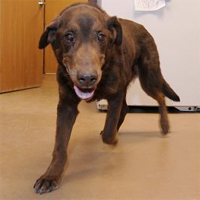Max, a Labrador Retriever from Lincoln, Neb., has always been an active dog. But at 13-years-old, it’s no wonder the chocolate Lab has started to slow down a bit. When Max was diagnosed with arthritis last year, the once spunky pup had to live his life on the sidelines due to severe joint pain. Neither pain medications nor anti-inflammatories seemed to get old Max back on his feet.
Lucky for Max, his owner, Pat McInteer, is also an experienced veterinarian at Hillcrest Animal Clinic in Lincoln. Seeing the affect arthritis had on Max’s quality of life was really difficult, Dr. McInteer says.
“His hips and knees and back are arthritic,” Dr. McInteer tells KLKN-TV ABC 8 News. “He played and ran hard his whole life.”
Dr. McInteer first adopted Max during veterinary school. Max was only 8 weeks old then, a puppy with boundless energy, and it was love at first sight for the vet student. “My intention for Max was for him to be my companion and buddy, Dr. McInteer explains.
After well over a decade together, Dr. McInteer wasn’t content to sit idly by while arthritis continued to have crippling affects on his four-legged best friend.
That’s why Dr. McInteer chose Max to be the first puppy patient in his vet practice — and in the entire state of Nebraska — to undergo a revolutionary stem cell procedure that should combat canine arthritis and help Max get moving again.
Using a treatment developed by Kentucky-based MediVet America, a veterinary science company, Dr. McInteer was able to use Max’s own stem cells to regenerate tissue that has been damaged by arthritis.
During the less than five-hour procedure, Max was injected with a local anesthetic. Dr. McInteer then carefully removed a piece of adipose tissue — fat cells — from Max’s shoulder area. For the next few hours, stem cells from Max’s adipose tissue were separated out, then re-injected into Max’s arthritic joints. These stem cells should help regenerate the damaged ligaments in Max’s arthritic limbs, alleviating pain and increasing mobility.
“We treat right at the source of the pain,” Dr. McInteer tells the San Francisco Chronicle. “Stem cells have a homing ability. They will find inflammation we didn’t know was there.”
While Max recovers, Dr. McInteer is anxiously watching for signs the stem cell therapy is working.
Dr. McInteer expects that, within the next month, his best friend should hopefully be able to get around without difficulty. “I know this is not going to make a thirteen year old turn four,” he says. “I just want him to enjoy thirteen as much as he can.”
According to the Lincoln Journal Star, nearly 20 percent of adult dogs and 45 percent of cats are afflicted with arthritis. Animals suffering from conditions such as hip dysplasia, degenerative diseases, and certain joint, ligament, and cartilage injuries could also benefit from the adipose stem cell procedure.
Stem cell therapy might be the way of the future for animal medicine, though more studies are necessary to fully determine the procedure’s effectiveness. In addition to treating joint and ligament conditions, clinical trials are currently underway as doctors try to determine if stem cells can help reverse the effects of renal failure in cats.
Sources: KLKN-TV ABC 8 News, San Francisco Chronicle, Lincoln Journal Star





